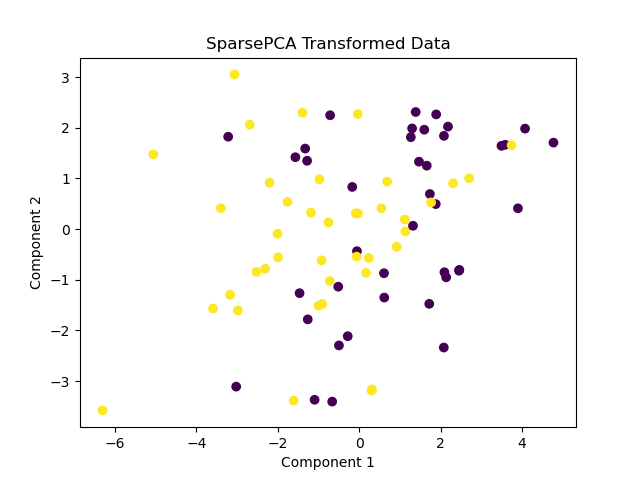SparsePCA is a variation of Principal Component Analysis (PCA) that results in sparse components, making it useful for feature selection and improving interpretability.
SparsePCA’s main hyperparameters include n_components (number of components to keep) and alpha (sparsity controlling parameter).
This algorithm is suitable for dimensionality reduction in regression and classification problems, especially when interpretability and feature selection are important.
from sklearn.decomposition import SparsePCA
from sklearn.datasets import make_classification
from sklearn.model_selection import train_test_split
import matplotlib.pyplot as plt
# Generate synthetic dataset
X, y = make_classification(n_samples=100, n_features=10, n_informative=5, n_classes=2, random_state=1)
# Split dataset into train and test sets
X_train, X_test, y_train, y_test = train_test_split(X, y, test_size=0.2, random_state=1)
# Create SparsePCA model
model = SparsePCA(n_components=5, alpha=1)
# Fit model
X_train_transformed = model.fit_transform(X_train)
# Transform test data
X_test_transformed = model.transform(X_test)
# Plot transformed dataset
plt.scatter(X_train_transformed[:, 0], X_train_transformed[:, 1], c=y_train)
plt.xlabel('Component 1')
plt.ylabel('Component 2')
plt.title('SparsePCA Transformed Data')
plt.show()
Running the example gives an output like:

The steps are as follows:
First, a synthetic binary classification dataset is generated using
make_classification(), with 100 samples, 10 features, and 5 informative features. The dataset is split into training and test sets usingtrain_test_split().Next, a
SparsePCAmodel is instantiated withn_componentsset to 5 andalphaset to 1. The model is then fit on the training data using thefit_transform()method.The test data is transformed using the
transform()method.A scatter plot is created to visualize the transformed training dataset, showing the first two components. This demonstrates how SparsePCA reduces the dimensionality of the data while maintaining its structure for further use in machine learning tasks.
This example shows how to set up and use a SparsePCA model for dimensionality reduction, highlighting the interpretability and feature selection benefits of this algorithm in scikit-learn.
